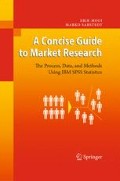Abstract
lie at the heart of conducting market research. By data we mean a collection of facts that can be used as a basis for analysis, reasoning, or discussions. Think, for example, of the answers people give to surveys, existing company records, or observations of shoppers’ behaviors.
Learning Objectives
After reading this chapter you should understand:
– How to explain what kind of data you use.
– The differences between qualitative and quantitative data.
– What the unit of analysis is.
– When observations are independent and when they are dependent.
– The difference between dependent and independent variables.
– Different measurement scales and equidistance.
– The differences between primary and secondary data.
–from a conceptual viewpoint.
– How to set up several different sampling designs.
– How to determine acceptable sample sizes.
Access this chapter
Tax calculation will be finalised at checkout
Purchases are for personal use only
References
Armstrong JS, Overton TS (1977) Estimating nonresponse bias in mail surveys. J Mark Res 14(August):396–403
Bearden WO, Netemeyer RG (1999) Handbook of marketing scales. Multi-item measures for marketing and consumer behavior research, 2nd edn. Sage, Thousand Oaks, CA
Bergkvist L Rossiter JR (2007) The predictive validity of single-item versus multi-item measures of the same construct. J Mark Res 44(2):175–184.
DeVellis RF (2003) Scale development: theory and applications, 2nd edn. Sage, Thousand Oaks, CA
Diamantopoulos A, Riefler P, Roth KP (2008) Advancing formative measurement models. J Bus Res 61(12):1203–1218
Diamantopoulos, A, Winklhofer HM (2001) Index construction with formative indicators: an alternative to scale development. J Mark Res 38(2):269–277
Erdem T, Swait J (2004) Brand credibility, brand consideration, and choice. J Consum Res 31(June):191–198
Fischer M, Völckner F, Sattler H (2010) How important are brands? A cross-category, cross-country study. J Mark Res 47(5):823–839
Fuchs C, Diamantopoulos A (2009) Using single-item measures for construct measurement in management research. Conceptual issues and application guidelines. Die Betriebswirtschaft 69(2):195–210
Geyskens I, Steenkamp J-BEM, Kumar N (1998) Generalizations about trust in marketing channel relationships using meta-analysis. Int J Res Mark 15(July):223–248
Netemeyer RG, Bearden WO, Sharma S (2003) Scaling procedures: issues and applications. Sage, Thousand Oaks, CA
Rossiter JR (2010) Measurement for the social sciences. Springer, New York
Sarstedt M, Schloderer MP (2010) Developing a measurement approach for reputation of non-profit organizations. Int J Nonprofit Volunt Sect Mark 15(3):276–299
Sarstedt M, Wilczynski P (2009) More for less. A comparison of single-item and multi-item measures. Die Betriebswirtschaft 69(2):211–227
Author information
Authors and Affiliations
Rights and permissions
Copyright information
© 2010 Springer Berlin Heidelberg
About this chapter
Cite this chapter
Mooi, E., Sarstedt, M. (2010). Data. In: A Concise Guide to Market Research. Springer, Berlin, Heidelberg. https://doi.org/10.1007/978-3-642-12541-6_3
Download citation
DOI: https://doi.org/10.1007/978-3-642-12541-6_3
Published:
Publisher Name: Springer, Berlin, Heidelberg
Print ISBN: 978-3-642-12540-9
Online ISBN: 978-3-642-12541-6
eBook Packages: Business and EconomicsBusiness and Management (R0)

